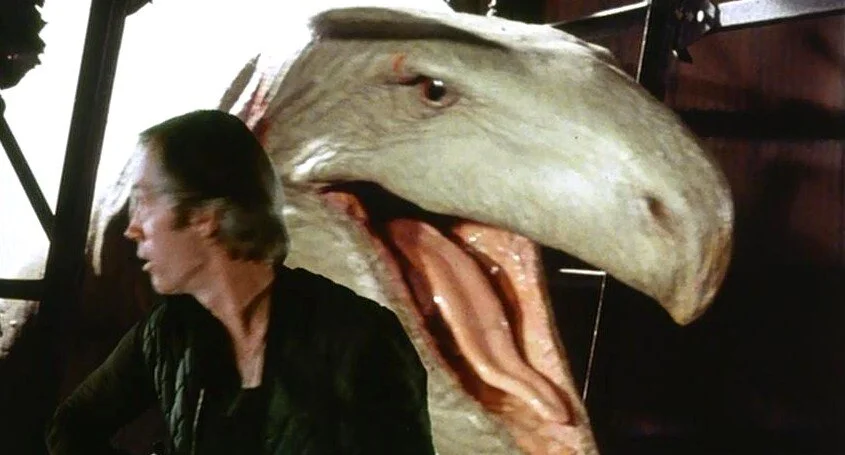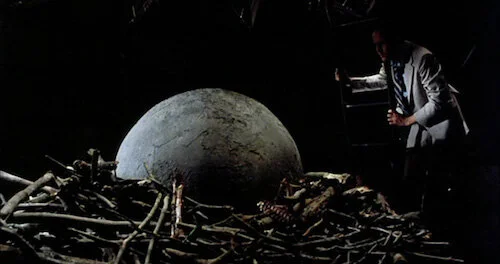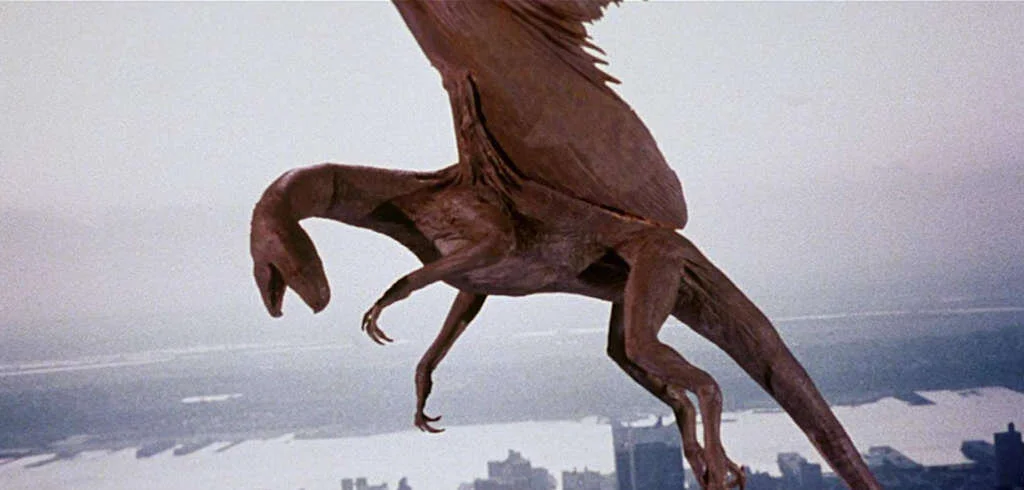Q (1982)
If you had someone watch writer/director Larry Cohen’s cult classic monster movie Q for the first time and then describe the plot, it’s highly doubtful that they would claim it is a movie that boils down to two aggrieved men, righteously pissed off at the world, each trying to take their own revenge on society. I honestly doubt that is how the late Cohen would describe the film either.
As much as the legendary indie filmmaker did not shy away from subverting genre expectations by offering up healthy doses of social commentary, he was first and foremost an entertainer. While Q definitely delivers on the entertainment side of monster movie filmmaking with its titular stop-motion, flying serpent diving out of the skies and snatching New Yorkers from rooftops, the “why” of the creature is never really answered. The eventual discovery that the serpent is the ancient Aztec god Quetzalcόatl that has been resurrected by Kahsa, a medical student of apparent Latin American (actor Shelly Desai is actually of Indian heritage, but that’s an essay for another time) origins who is performing human sacrifices, is almost tossed off as unimportant. Cohen just treats this as a necessary plot point to tie up a movie that is meant to be purer entertainment than many of his more serious-minded pictures from the previous decade.
I have watched Q at least a dozen times over the years. Honestly, it was not until the last two times I watched it that I questioned just why Kahsa wanted to resurrect a god in the guise of a flying serpent covered in feathers that attacks people completely at random?
There is no connection between any of the victims other than they are on rooftops, making them easy prey. Cohen does not even go the easy route of making the victims smug assholes deserving of a comeuppance. What is Kahsa’s end game?
Whether Cohen intended it or if it was something simmering in his subconscious that made it into the finished movie, there is an element of supernatural revenge at play in Kahsa’s motives. It is implied that Kahsa is a descendant of the Aztec civilization.
With that in mind, he would have a pretty serious grudge to hold against the descendants of the invading Europeans who all but wiped his ancestors off the face of the Earth. If Quetzalcόatl actually had existed and disappeared at the same time as the people that worshipped it, it seems like not much of a leap in logic to assume its sudden introduction to modern New York City would be more than a little disorienting for it and it would see all the people in clothing, buildings, and machines it does not recognize as more invaders of its domain. In that case, it would only do what comes naturally to defend its territory.
At this point, I can forgive any readers out there who are rolling their eyes at the number of leaps I just made to bring a little gravity to a fun monster movie where a window washer gets his head bitten off in the opening scene. But when you factor in the dismissive attitudes by nearly every character in the film to the worship of Quetzalcόatl by the Aztecs, it does make sense that Kahsa might go to such extremes to bring a god back from the dead for revenge on the modern society built upon the extermination of his culture. In that scenario, maybe Quetzalcόatl’s killing of Sgt. Powell (Richard Roundtree) is less an attempt to shock an audience who didn’t expect Shaft to die so early in the third act and more a pre-mediated murder since he is the one who looks at the body of one of Kahsa’s human sacrifices and condescendingly says, “Luckily, all we have to do nowadays is take the wafer and drink the wine. That’s what I call being civilized.” It’s a marked line in the sand, declaring modern Catholocism/Christianity as superior to the religions it has largely replaced.
Kahsa has something of a cracked mirror image in Jimmy Quinn (Michael Moriarty), the two-bit crook who discovers the nest of Quetzalcόatl (and the giant egg of its unhatched offspring) at the top of the Chrysler Building. Realizing the gold mine he is sitting on, Quinn holds the city hostage for a big payday before he will reveal the location of the nest.
While their motivations for sticking it to the system differ, both Kahsa and Quinn have deeply held anger at society. Kahsa’s anger comes from the systematic extermination of his ancestors and a modern world that views the cultural artifacts left behind by them as curiosities to house in a museum. Quinn’s anger comes from what he sees as a society designed to keep men like him under the thumb of a corrupt legal system.
Quinn spends the movie telling lies and half-truths to everyone, including himself.
But Moriarty’s performance notably changes when he unleashes his fury at being framed by the police when he was just a teenager that sent him on a life of crime, culminating with him screaming, “This city owes me one!” It’s the first of two moments in the movie when Quinn tells the unvarnished truth.
The second moment of truth from Quinn comes at the end of the film, as Kahsa tries to force him into willingly giving his life in a human sacrifice to atone for his part in the death of Quetzalcόatl and its offspring. Quinn’s confusion at the situation gives way to a realization that this is probably the end for him, bringing out his truth when Kahsa tries to make him say a prayer for the ceremony. Quinn’s response could be seen as offending Kahsa’s religion: “Piss on your prayer. I ain’t sayin’ any goddamn prayers. I never did, I never will.” But Quinn’s response is not intended to be religious intolerance—he doesn’t care about religion; it’s simply his way of not letting himself be pushed around anymore, even when someone has a knife to his throat.
The obvious irony of the ending is that by refusing to say the prayer, Quinn buys enough time for the cops to unceremoniously shoot Kahsa in the back of the head. By embracing his true, self-pitying nature, Quinn inadvertently saves the society that has no use for him by helping facilitate the killing of the one person who could resurrect Quetzalcόatl and re-start the mass killings of New Yorkers. Cohen plays the moment as one of redemption for Quinn as he strides off into what he professes will be a life on the straight and narrow (good luck with that), but there is the underlying ugliness that the NYPD has finally finished off what the invading Spanish conquistadors started four hundred years earlier. It’s a bleak but fitting end to the film.






